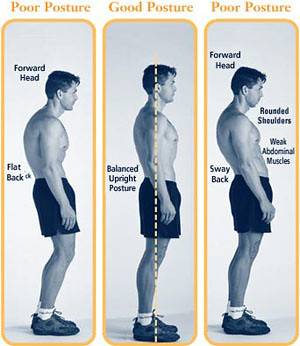The Importance of Posture
VIRTUALLY EVERYONE—young and old, male or female—has a
deep desire to improve his or her life. However, many people
have orthopedic problems that prevent them from improving
their bodies. These problems occur from a lack of core
stabilization and strength, leading to poor posture.
Our bodies were designed to withstand many environmental
conditions. The ability to stabilize our core musculature is vital
to our existence. Our ancient ancestors could not afford to have
back pain. They needed to function on a basic level that
involved moving rocks, building shelter, climbing mountains, or
running after food. If they had a bad back or poor core
stabilization and strength, their likelihood of survival would
have been deeply diminished.

Core Stabilization and Strength
Our core musculature contributes to vital functions within our
bodies and enables us to perform simple to complex tasks.
Without good control or stabilization and a thorough
understanding of what contributes to core stabilization and
strength, we can fall prey to many of modern society’s ailments.
Lower back pain is the number one patient complaint in
America.
Many problems and orthopedic injuries result from poor core
stabilization and strength. Females appear to be at a higher risk of suffering such injuries. Jame Zachazewki shows evidence of this in a study he conducted in 1996. He discovered that women
have a lack of strength in the lower abdominals and pelvic floor
muscles. He explained that 47% of females age 38 and above
suffer from incontinence. However, women who participated in
a regular weight-training program reduced the incidence of
incontinence to only 4%.
The Benefits of Weight Training
A weight-training program enables the body to communicate
better and increase strength and stabilization. Elderly women
can further benefit from a weight training program, which can
improve balance, increase muscle mass, influence bone density
(combating osteoporosis), and help to manage osteoarthritis.
We first must look at the functional anatomy of our core
musculature. We need to understand the benefits that a good
core conditioning program can have on our livelihood. A core
conditioning program will decrease the likelihood of back and
neck pain, incontinence, ruptured disks, muscle and ligament
strains, all while improving posture.
To begin understanding the complexity of our core and how it
relates to overall function, we must address the inner an outer
unit and how they work in harmony allowing us to function at a
higher level.
A simple and brief anatomy lesson should help you understand
how these units work. The muscles involved are broken down
into separate but interconnected inner and outer units. The
inner unit is the topic of the next post.
Sharing is sexydeep desire to improve his or her life. However, many people
have orthopedic problems that prevent them from improving
their bodies. These problems occur from a lack of core
stabilization and strength, leading to poor posture.
Our bodies were designed to withstand many environmental
conditions. The ability to stabilize our core musculature is vital
to our existence. Our ancient ancestors could not afford to have
back pain. They needed to function on a basic level that
involved moving rocks, building shelter, climbing mountains, or
running after food. If they had a bad back or poor core
stabilization and strength, their likelihood of survival would
have been deeply diminished.

Core Stabilization and Strength
Our core musculature contributes to vital functions within our
bodies and enables us to perform simple to complex tasks.
Without good control or stabilization and a thorough
understanding of what contributes to core stabilization and
strength, we can fall prey to many of modern society’s ailments.
Lower back pain is the number one patient complaint in
America.
Many problems and orthopedic injuries result from poor core
stabilization and strength. Females appear to be at a higher risk of suffering such injuries. Jame Zachazewki shows evidence of this in a study he conducted in 1996. He discovered that women
have a lack of strength in the lower abdominals and pelvic floor
muscles. He explained that 47% of females age 38 and above
suffer from incontinence. However, women who participated in
a regular weight-training program reduced the incidence of
incontinence to only 4%.
The Benefits of Weight Training
A weight-training program enables the body to communicate
better and increase strength and stabilization. Elderly women
can further benefit from a weight training program, which can
improve balance, increase muscle mass, influence bone density
(combating osteoporosis), and help to manage osteoarthritis.
We first must look at the functional anatomy of our core
musculature. We need to understand the benefits that a good
core conditioning program can have on our livelihood. A core
conditioning program will decrease the likelihood of back and
neck pain, incontinence, ruptured disks, muscle and ligament
strains, all while improving posture.
To begin understanding the complexity of our core and how it
relates to overall function, we must address the inner an outer
unit and how they work in harmony allowing us to function at a
higher level.
A simple and brief anatomy lesson should help you understand
how these units work. The muscles involved are broken down
into separate but interconnected inner and outer units. The
inner unit is the topic of the next post.

 Previous Entries
Previous Entries




0 comments for this post
Leave a reply